 |
 |
 |
| |
Locteron Viral Kinetics and Anti-Viral Activity during Treatment with a Controlled-Release Interferon Alfa-2b in Genotype 1 Chronic Hepatitis C Patients
|
| |
| |
Reported by Jules Levin
43rd EASL
April 23-27, 2008
Milan, Italy
E. Herrmann1, S. Zeuzem2, I. Dziublyk3, L. Moroz4, I. Zaytsev5, S. Martens2, E. van Hoogdalem6, J. Humphries7
1Saarland University, Homburg/Saar, Germany; 2J.W. Goethe-University Hospital Frankfurt; 3National Medical Academy, Kiev, Ukraine;
4National Medical University, Vinnitsa, Ukraine; 5State Medical University, Donetsk, Ukraine; 6OctoPlus N.V., Leiden, The Netherlands;
7Biolex Therapeutics, Pittsboro, NC, USA
AUTHOR CONCLUSIONS
In this study, Locteron, a controlled-release formulation of unmodified IFN-alfa2b, administered every 2 weeks to treatment-na•ve patients with chronic hepatitis C (genotype 1) demonstrated strong anti-viral activity combined with an improved safety and tolerability profile compared to currently marketed interferons and those in development.
Viral kinetic analysis demonstrated a dose-dependent anti-viral efficiency with a decrease of ALT levels. Furthermore, OAS levels and neopterin concentrations increased dose-dependently early during treatment.
BACKGROUND
Controlled-release recombinant interferon alfa2b (IFN-alfa2b, Locteron) is a novel approach to delivery of interferon. As a result of the slow release of high doses of interferon (up to 200 MIU), tolerability is importantly improved over pegylated interferons, with similar if not improved efficacy, in addition to less frequent dosing.
STUDY OBJECTIVE
A Phase 2a, open-label, dose-ranging study was conducted in treatment-na•ve patients with genotype 1 chronic HCV infection to evaluate the safety and anti-viral effect of Locteron. Here, we analyzed viral kinetics as well as kinetics of alanine aminotransferase (ALT), 2Õ3Õ-oligoadenylate synthetase (OAS) and neopterin concentrations.
METHODS
Thirty-two patients were randomized to receive subcutaneous injections of Locteron 14 days apart over 12 weeks in 4 dose cohorts (8 per cohort) of 160, 320, 480 and 640 ug, with the 640 ug group starting after safety evaluation of the other cohorts. All subjects received weight-based ribavirin between 800-1400 mg/day. Analysis of IFN-alfa2b in human serum samples was performed by a modified ELISA from GE HealthCare, UK, using standards and quality controls prepared from IFN-alfa2b (BLX-883). LLOQ for IFNalfa2b using the ELISA was 2.5 pg/mL (A. Kromminga, IPM, Hamburg, Germany).
Viral kinetics for the first 4 weeks were modeled mathematically from a full PK-PD model according to the individual pharmacokinetic profile of Locteron for all patients. The compartmental model was based on a differential equation system including a time-varying efficiency factor according to the respective serum levels of Locteron.
Furthermore, ALT, OAS and neopterin concentrations were evaluated.
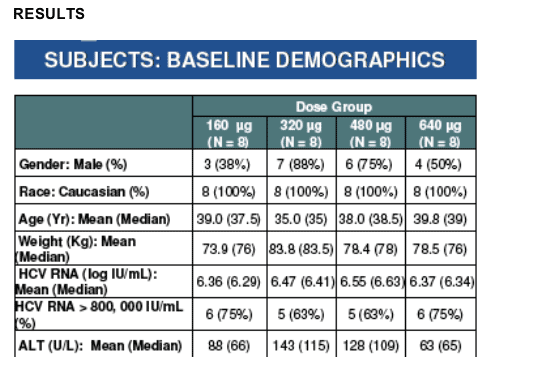
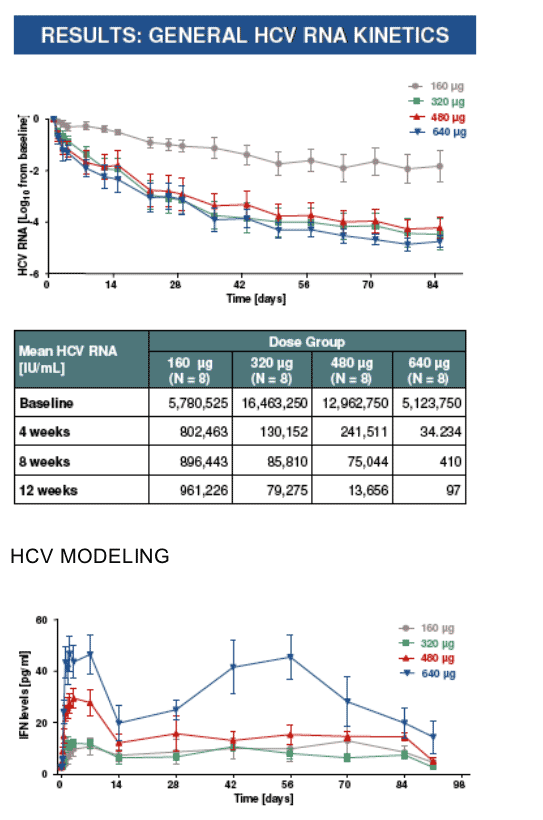
With individual PK, viral kinetics were analyzed by a full PK-PD model. Modeling again demonstrated a clear dose-dependent effect on anti-viral mean and maximal efficiency (Jonckheere-Terpstra-Test: p=0.003 and p=0.006, respectively).
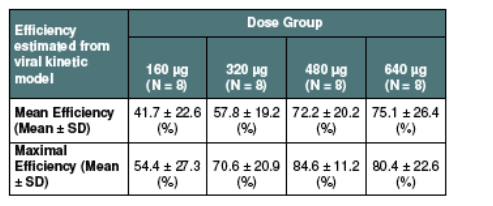
Furthermore, median half-life of free virus of 2.1 hours as well as the half-life of infected cells of 2.78 days are in concordance with previous viral kinetic results with interferon-based treatment combined with ribavirin. Individual viral kinetic data for 3 typical patients (out of 8) of each of the 4 dose groups are shown in the following figures. Either no rebound or only a very minor rebound of HCV RNA could be observed at the end of the dosing periods.
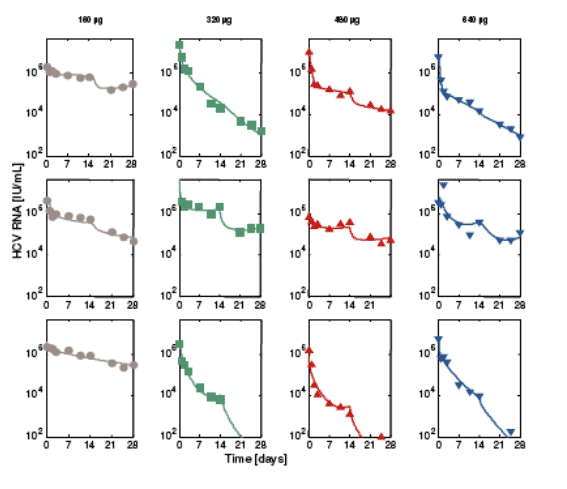
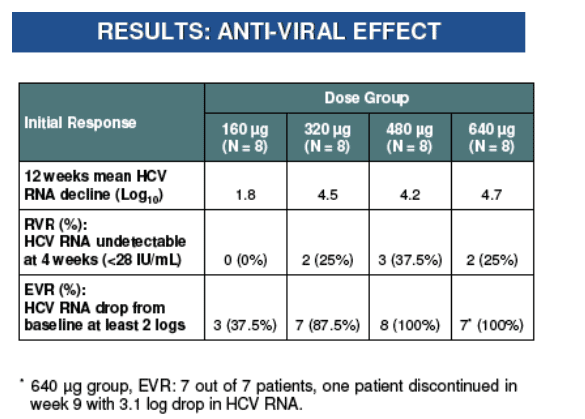
OAS AND NEOPTERIN
Neopterin and OAS increased early during treatment. There was a clear dose-dependent effect in terms of a faster and more pronounced increase of neopterin concentrations in the higher dosing groups (p=0.03 and p=0.006, respectively) and a dose-dependent effect in terms of a faster increase and a trend to a more pronounced increase of OAS in the higher dosing groups (p=0.03 and p=0.065, respectively). The following figures show box-and-wisker diagrams illustrating the quartiles and range of the respective distributions. Outliers are shown as circles, extreme outliers as asterisk.
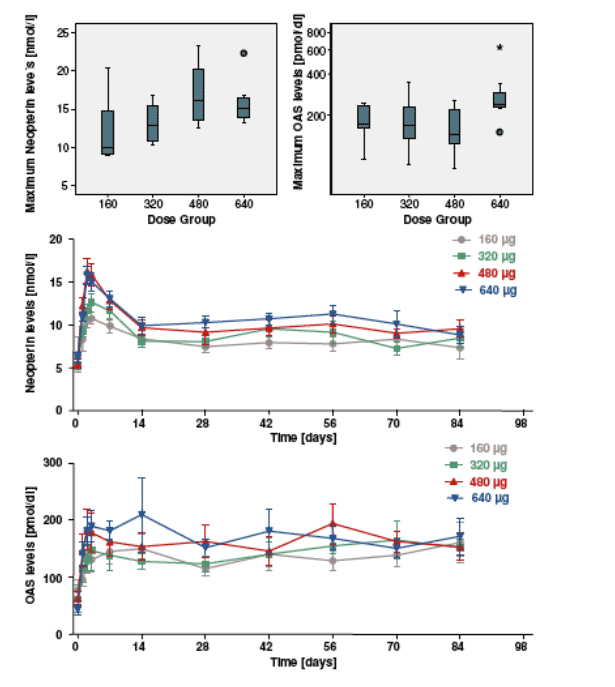
ALT KINETICS
ALT dynamics typically showed a short intermediate increase followed by a decline. At baseline, ALT was 105 ± 68 U/L, and after 4 weeks of treatment, ALT was 57 ± 29, 58 ± 30, 46 ± 22, and 28 ± 13 U/L in the 160, 320, 480, and 640 ug cohorts, respectively, confirming a clear improvement of ALT during Locteron treatment.
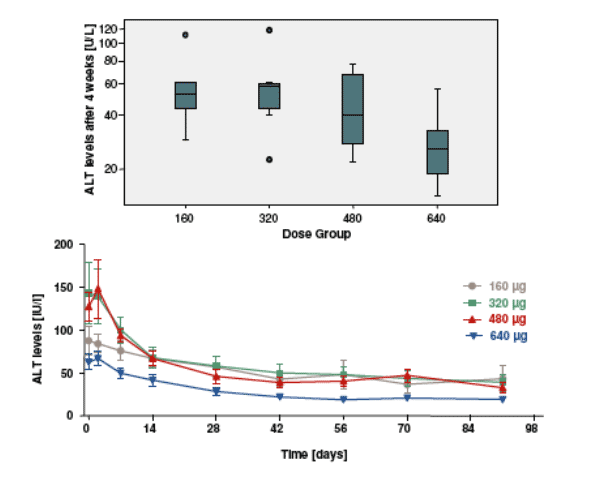
|
| |
|
 |
 |
|
|